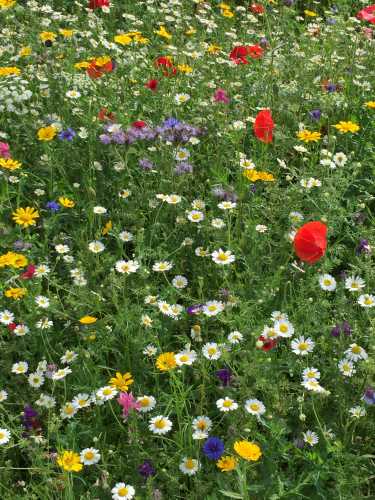How Clover Benefits Bees And Agriculture
Elsewhere on this site, I have written about why clover is beneficial for bees, and I advocate allowing patches of clover to flourish in lawns.
For some years now, I have also encouraged the use of clover by councils for incorporating into grassy verges and other suitable areas of publicly owned land.
However, clover is also highly suited for use in agriculture, and a comprehensive research paper: 'Clover in agriculture: combined benefits for bees, environment, and farmer' (Harris et al 2022) outlines the many advantages of its use.
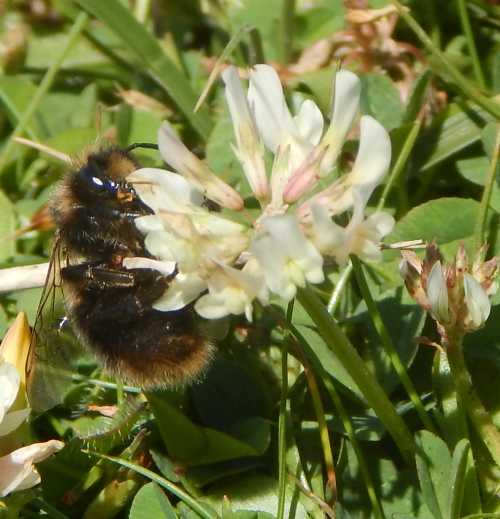
Why Farmers, Bees And The Environment Benefit From Clover
Farmers have a major role to play in safeguarding the environment, and many are already taking steps to help pollinators, particularly by incorporating pollinator margins - i.e. stretches of wildflowers along the perimeters of their fields.
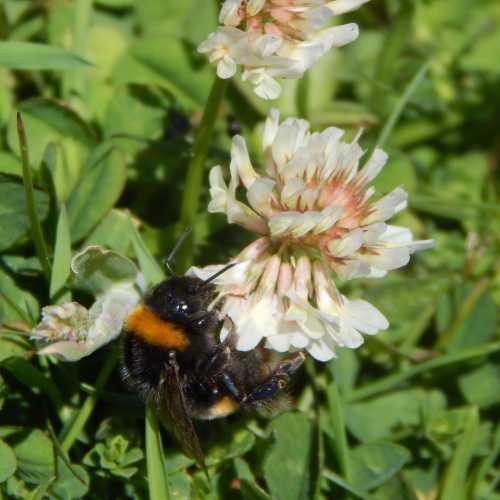
The cost of fertilisers and focus on clover
There is increasing concern over the cost and environmental impact of high nitrogen inputs in agriculture1.
High applications of nitrogenous fertiliser leads to damaging flows of excess nitrogen into watercourses, and the industrial manufacture and delivery of nitrogen products increases
greenhouse gas production.
As a result of this concern, there has been an increased focus on the use of clover in agriculture2, for four main reasons:
- Clover can ‘fix nitrogen’ (convert atmospheric free nitrogen into agriculturally important compounds such as nitrates)3 due to the presence of the symbiotic root bacterium Rhizobium, thus reducing the need to add unnaturally large quantities of nitrogen compounds into the soil;
- Some insect science experts claim that the increased use of artificial nitrogenous additives is part of the process of agricultural intensification, which is part of the reason for the reduction in pollinators4,5;
- Clover is itself a very good animal feed, with a higher nitrogen content than grass6;
- Clover is an important source of nectar and pollen for bumble bees and honey bees4,7 .
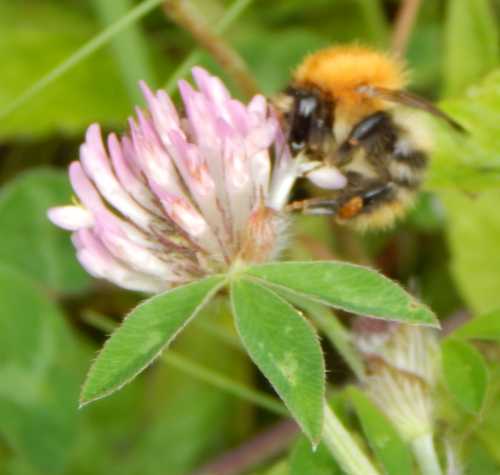
Benefits of clover
Harris et al outline the benefits for agriculture of using clover with grass in place of high input grass monoculture as follows, showing four main improvements.
Yield Benefits
Firstly, there is improved yield of arable crops grown in fields used for rotation after livestock grazing on grass and clover mix, due to improved soil fertility where clover is planted 8,9.
Livestock
Secondly, there is improved livestock ‘performance’ where livestock is reared on pasture that is grass with
clover compared to monoculture grass supplemented with nitrogenous fertilisers 10,11 .
Pollinator presence and crop yield
There is increased pollinator presence, leading to improvement in crop yield of pollinator-dependent crops.
Harris et al quote numerous studies that show an increase in honey bee, bumble bee and other pollinator insects on farmland where clover is planted.
Cost benefits
Finally, there is reduced cost to farmers of artificial nitrogen-based fertilisers.
Farmers need support
Of course, it's important that farmers receive the incentives and support they need to be able to switch to grass plus clover swards, which Harris et al acknowledge.
Let's hope governments, farming and environment agencies provide the help that is needed.
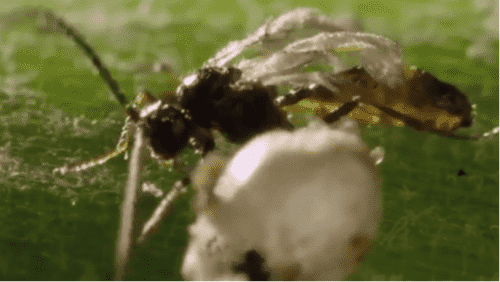
Body Snatcher Wasps!
Why are farmers turning to wasps to help them control crop eating pests?
References
[The references below as used in the Harris et al paper: Harris, C., Ratnieks, F.L.W. Clover in agriculture: combined benefits for bees, environment, and farmer. J Insect Conserv 26, 339–357 (2022). https://doi.org/10.1007/s10841-021-00358-z]
1. DEFRA (2018) Reviewing the opportunities, barriers and constraints for organic management
techniques to improve sustainability of conventional
farming. http://sciencesearch.defra.gov.uk/Default.aspx?
2. Andrews M, Scholefield D, Abberton MT et al (2007) Use of white clover as an alternative to
nitrogen fertiliser for dairy pastures in nitrate vulnerable zones in the UK: productivity, environmental impact and economic considerations. Ann Appl Biol
151:11–23. https://doi.org/10.1111/j.1744-7348.2007.00137.x.
3. Ledgard SF, Sprosen MS, Penno JW, Rajendram GS (2001) Nitrogen fixation by white clover in
pastures grazed by dairy cows: Temporal variation and effects of nitrogen fertilization. Plant Soil 229:177–187. https://doi.org/10.1023/A:1004833804002.
4. Goulson D, Hanley ME, Darvill B et al (2005) Causes of rarity in bumblebees. Biol Conserv
122:1–8. https://doi.org/10.1016/j.biocon.2004.06.017.
5. Ollerton J, Erenler H, Edwards M, Crockett R (2014) Extinctions of aculeate pollinators in
Britain and the role of large-scale agricultural changes. Science
346:1360–1362. https://doi.org/10.1126/science.1257259.
6. Peyraud JL, Le Gall A, Lüscher A (2009) Potential food production from forage legume-based systems in Europe: an overview. Irish J Agric Food Res 48:115–135.
7. Decourtye A, Mader E, Desneux N (2010) Landscape enhancement of floral resources for honey bees in agro-ecosystems. Apidologie 41:264-277.
https://doi.org/10.1051/apido/2010024.
8. Doel JM (2013) Accumulation and recovery of nitrogen in mixed farming systems using legumes and other fertility-building crops.
9. Stopes C, Millington S, Woodward L (1996) Dry matter and nitrogen accumulation by three leguminous green manure species and the yield of a following wheat crop in an organic production system. Agric Ecosyst Environ 57:189–196. https://doi.org/10.1016/0167-
8809(95)01002-5.
10. Chapman DF, Lee JM, Rossi L et al (2017) White clover: the forgotten component of high-producing pastures? Anim Prod Sci 57:1269–1276. https://doi.org/10.1071/AN16453
11. Doyle CJ, Morrison J, Brockman JS et al (1984) Economic aspects of using legumes. Forage Legum, pp 152–165.
If you found this page helpful or interesting, I'd really be grateful if you would share it with others - if not this page, perhaps another, such as Gardening For Bees.
Thank you so much :) .
